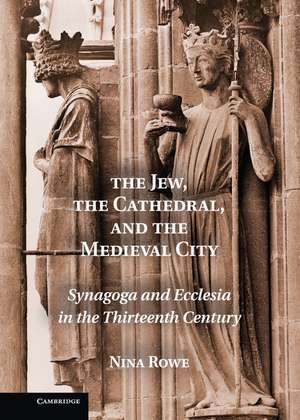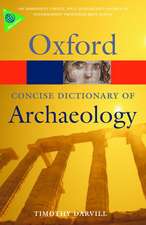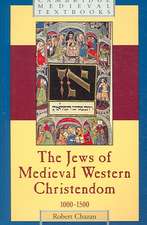The Jew, the Cathedral and the Medieval City: Synagoga and Ecclesia in the Thirteenth Century
Autor Nina Roween Limba Engleză Hardback – 3 apr 2011
Preț: 711.33 lei
Preț vechi: 799.25 lei
-11% Nou
Puncte Express: 1067
Preț estimativ în valută:
136.11€ • 142.40$ • 113.07£
136.11€ • 142.40$ • 113.07£
Carte tipărită la comandă
Livrare economică 03-17 aprilie
Preluare comenzi: 021 569.72.76
Specificații
ISBN-13: 9780521197441
ISBN-10: 0521197449
Pagini: 346
Ilustrații: 162 b/w illus.
Dimensiuni: 180 x 254 x 25 mm
Greutate: 0.98 kg
Editura: Cambridge University Press
Colecția Cambridge University Press
Locul publicării:New York, United States
ISBN-10: 0521197449
Pagini: 346
Ilustrații: 162 b/w illus.
Dimensiuni: 180 x 254 x 25 mm
Greutate: 0.98 kg
Editura: Cambridge University Press
Colecția Cambridge University Press
Locul publicării:New York, United States
Cuprins
Introduction: the Jew, the cathedral and the city; Part I. Imagining Jews and Judaism in Life and Art: 1. The Jew in a Christian world: denunciation and restraint in the age of cathedrals; 2. Ecclesia and Synagoga: the life of a motif; Part II. Art and Life on the Ecclesiastical Stage - Three Case Studies: Introduction to Part II: nature, antiquity and sculpture in the early thirteenth century; 3. Reims: 'our Jews' and the royal sphere; 4. Bamberg: the empire, the Jews and earthly order; 5. Strasbourg: clerics, burghers and Jews in the medieval city; Epilogue: the afterlife of an image.
Recenzii
'Rowe's approach to her work is impressively versatile, drawing historical, textual, and material evidence into synthesis with formal and stylistic observations to walk the line attentively between the worm's-eye and the bird's-eye view of her subject. The breadth and soundness of the resulting book will interest a wide range of scholars in fields from art history and Jewish studies to theology, anthropology and beyond. The Jew, the Cathedral and the Medieval City … represents a masterful scholarly accomplishment and a signal contribution to medieval studies.' The Medieval Review
'Rowe's study represents a valuable contribution to the corpus of scholarship on Jewish-Christian interaction, medieval urban history and Gothic art. Scholars and students alike will want to familiarize themselves with Rowe's arguments and imitate her interpretative methodologies.' German History
'The Jew, the Cathedral and the Medieval City is an excellent example of a study on the border between history and art history. … Rowe's work … sheds new light on the Synagoga-Ecclesia theme through a probing study of the political and ecclesiastical milieux that generated the monumental ensembles at three important cathedrals: Reims, Bamberg and Strasbourg.' Bulletin monumental
'Rowe's book is one of very few studies of German Gothic sculpture in English; that alone makes it a significant contribution. … What makes Rowe's study novel is her integration of the images into the social and political circumstances of their production and consumption, above all, those that involved the resident clergy's interactions with and attitudes toward Jews. The Art Bulletin
'Nina Rowe has succeeded in providing scholars with a provocative foray into the difficult problem of the relationship of artistic evidence to the lived realities of social and political life. Often she is forced to speculate, but she is always forthright about the limitations of her evidence. Not everyone will agree with all her conclusions, but no one working in the general area of her concerns can afford to ignore them. Speculum
'Rowe's study represents a valuable contribution to the corpus of scholarship on Jewish-Christian interaction, medieval urban history and Gothic art. Scholars and students alike will want to familiarize themselves with Rowe's arguments and imitate her interpretative methodologies.' German History
'The Jew, the Cathedral and the Medieval City is an excellent example of a study on the border between history and art history. … Rowe's work … sheds new light on the Synagoga-Ecclesia theme through a probing study of the political and ecclesiastical milieux that generated the monumental ensembles at three important cathedrals: Reims, Bamberg and Strasbourg.' Bulletin monumental
'Rowe's book is one of very few studies of German Gothic sculpture in English; that alone makes it a significant contribution. … What makes Rowe's study novel is her integration of the images into the social and political circumstances of their production and consumption, above all, those that involved the resident clergy's interactions with and attitudes toward Jews. The Art Bulletin
'Nina Rowe has succeeded in providing scholars with a provocative foray into the difficult problem of the relationship of artistic evidence to the lived realities of social and political life. Often she is forced to speculate, but she is always forthright about the limitations of her evidence. Not everyone will agree with all her conclusions, but no one working in the general area of her concerns can afford to ignore them. Speculum
Notă biografică
Descriere
This book examines the Synagoga-Ecclesia motif in the thirteenth century and argues that the figures conveyed a political message of Christian ascendancy and Jewish submission.












